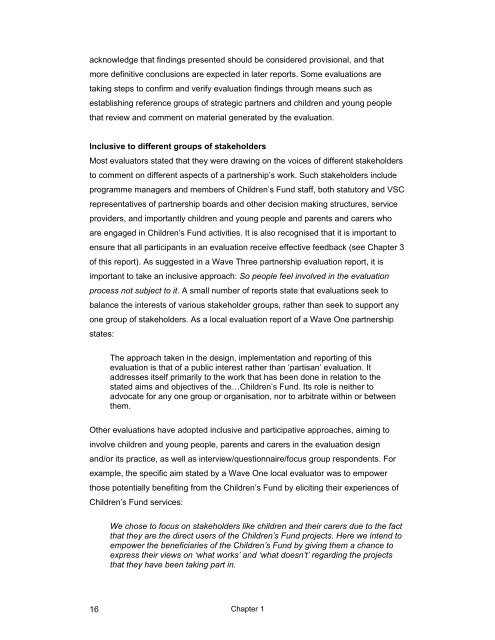Local Evaluation of Children's Services Learning from the Children's ...
Local Evaluation of Children's Services Learning from the Children's ...
Local Evaluation of Children's Services Learning from the Children's ...
- No tags were found...
Create successful ePaper yourself
Turn your PDF publications into a flip-book with our unique Google optimized e-Paper software.
acknowledge that findings presented should be considered provisional, and thatmore definitive conclusions are expected in later reports. Some evaluations aretaking steps to confirm and verify evaluation findings through means such asestablishing reference groups <strong>of</strong> strategic partners and children and young peoplethat review and comment on material generated by <strong>the</strong> evaluation.Inclusive to different groups <strong>of</strong> stakeholdersMost evaluators stated that <strong>the</strong>y were drawing on <strong>the</strong> voices <strong>of</strong> different stakeholdersto comment on different aspects <strong>of</strong> a partnership’s work. Such stakeholders includeprogramme managers and members <strong>of</strong> Children’s Fund staff, both statutory and VSCrepresentatives <strong>of</strong> partnership boards and o<strong>the</strong>r decision making structures, serviceproviders, and importantly children and young people and parents and carers whoare engaged in Children’s Fund activities. It is also recognised that it is important toensure that all participants in an evaluation receive effective feedback (see Chapter 3<strong>of</strong> this report). As suggested in a Wave Three partnership evaluation report, it isimportant to take an inclusive approach: So people feel involved in <strong>the</strong> evaluationprocess not subject to it. A small number <strong>of</strong> reports state that evaluations seek tobalance <strong>the</strong> interests <strong>of</strong> various stakeholder groups, ra<strong>the</strong>r than seek to support anyone group <strong>of</strong> stakeholders. As a local evaluation report <strong>of</strong> a Wave One partnershipstates:The approach taken in <strong>the</strong> design, implementation and reporting <strong>of</strong> thisevaluation is that <strong>of</strong> a public interest ra<strong>the</strong>r than ‘partisan’ evaluation. Itaddresses itself primarily to <strong>the</strong> work that has been done in relation to <strong>the</strong>stated aims and objectives <strong>of</strong> <strong>the</strong>…Children’s Fund. Its role is nei<strong>the</strong>r toadvocate for any one group or organisation, nor to arbitrate within or between<strong>the</strong>m.O<strong>the</strong>r evaluations have adopted inclusive and participative approaches, aiming toinvolve children and young people, parents and carers in <strong>the</strong> evaluation designand/or its practice, as well as interview/questionnaire/focus group respondents. Forexample, <strong>the</strong> specific aim stated by a Wave One local evaluator was to empowerthose potentially benefiting <strong>from</strong> <strong>the</strong> Children’s Fund by eliciting <strong>the</strong>ir experiences <strong>of</strong>Children’s Fund services:We chose to focus on stakeholders like children and <strong>the</strong>ir carers due to <strong>the</strong> factthat <strong>the</strong>y are <strong>the</strong> direct users <strong>of</strong> <strong>the</strong> Children’s Fund projects. Here we intend toempower <strong>the</strong> beneficiaries <strong>of</strong> <strong>the</strong> Children’s Fund by giving <strong>the</strong>m a chance toexpress <strong>the</strong>ir views on ‘what works’ and ‘what doesn’t’ regarding <strong>the</strong> projectsthat <strong>the</strong>y have been taking part in.16Chapter 1
















